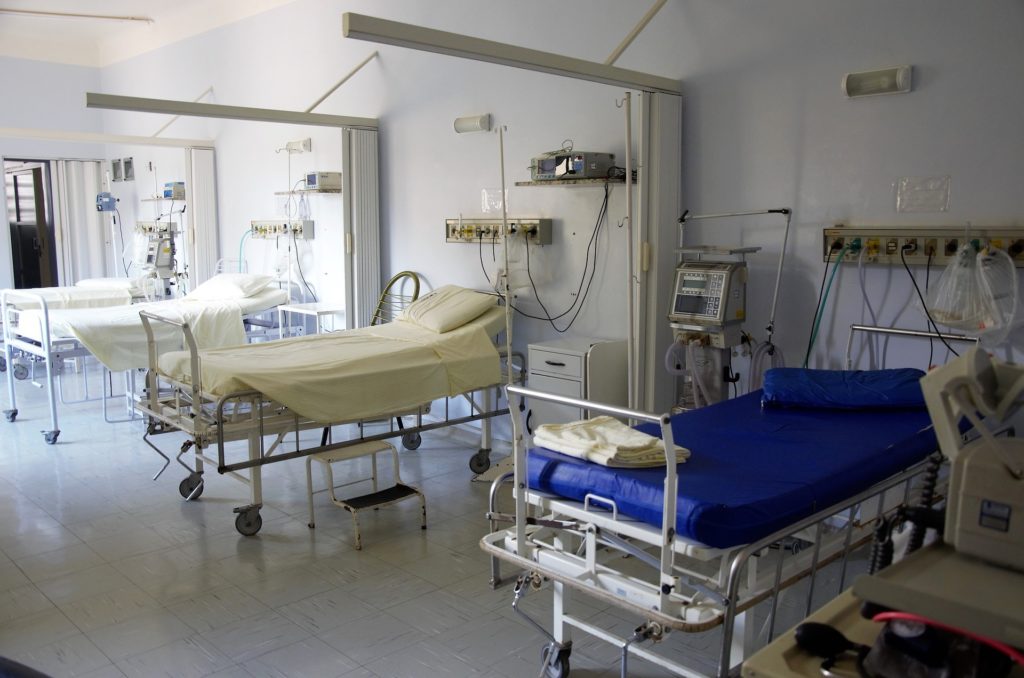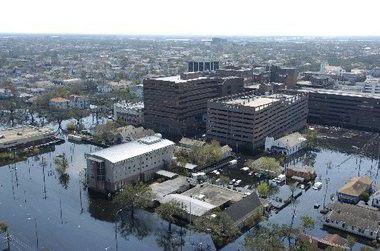
Our hospitals can flood and cut many beds. Bad news for a city that does flood.
Nearly 80% of hospitals in the New Orleans metro area are at risk of flooding from a Category 2 storm, the third-highest of any metropolitan area, according to a new study published in the journal GeoHealth last week. That translates to nearly 3,500 beds impacted in an area at high risk for devastating storms. “This stress in the form of a hurricane on a hospital system sort of shows us the problems in our health system,” said study author Dr. Aaron Bernstein, a pediatric hospitalist and interim director of the Center for Climate, Health, and the Global Environment, known as C-CHANGE, at the Harvard T.H. Chan School of Public Health. New Orleans has a higher bed-to-person ratio than many of the larger cities highlighted in the study like New York, Orlando and Miami. But a greater percentage of those beds are impacted by flooding. New Orleans and Houma also ranked high for risk of flooded roads surrounding the hospital. “If you can’t get people in or out of a hospital or supplies into a hospital, it’s not that helpful,” said Bernstein. “A lot of the problems crop up in buildings where they built Fort Knox, but they don’t have water because the water system fails outside the hospital or the lack of access to the outside world stretches well beyond a week.”
nola.com

For those living here this not a surprise as during Katrina my son in law, a doctor at Charity, evacuated to Houston.
For Louisiana residents who have weathered multiple devastating storms since 2005, this will come as no surprise. As recently as last year, Hurricane Ida tore off a hospital roof at Our Lady of the Sea in LaFourche Parish and busted through windows of Ochsner Health facilities. Back-up generators powering the intensive care unit failed at Thibodaux Regional Hospital, leaving staff carrying ventilated patients through dark, powerless stairwells. Tulane Lakeside in Metairie evacuated tiny newborns after losing water. But the study highlights how even low-level storms can put health care delivery and lives in jeopardy.
The rapid increase of the category of the storm often leave hospital unprepared.
New Orleans is better prepared than many of the cities on the list of top ten most affected areas, which includes many cities in Florida, Boston, New York and Philadelphia, because it is tested so often. Facilities like University Medical Center are built to withstand most things Mother Nature could throw at it. But even being walloped by storms regularly doesn’t always translate to widespread preparedness. “The thing that worries me most is that we continue to see very similar lessons learned from these types of disasters,” said Stephen Murphy, an expert planner in emergency preparedness at Tulane University. “So are we really learning them? Or are we just recognizing them?” Considering the pattern of rapid intensification of storms, Murphy said hospitals and those who provide protection and recovery for them have to be more nimble in deciding whether to evacuate and how they can prepare to shelter in place. University Medical Center has done a good job of that, but there are other hospitals that are more vulnerable and should invest more, said Murphy. “One preparedness dollar equates to about $4 on recovery expenses,” said Murphy. “That’s on the low end. Other studies have suggested that to be a 1-to-16 ratio.”
Katrina provided us with lessons. Have we learned them?
Dr. James Aiken and others who worked at Charity Hospital knew that the generators shouldn’t be in the basement long before Katrina threatened. The hospital emergency director asked for two federal grants to move them higher. Both were denied. As the water rose, it took out all the electricity and started to threaten patients on lower levels. The roots of trees that had grown deep enough to wrap around the water pipes wrenched them out of the ground, leaving them without access to water. “In the middle of the night, that Tuesday, we had to physically move out patients from the first floor to the second floor in the auditorium,” said Aiken, an emergency medicine physician and clinical associate professor at LSU Health New Orleans. Aiken said UMC has been built with intense storms in mind, and they’ve prepared as well as they can. But a massively powerful storm, such as Hurricane Ian that decimated Southwest Florida last week, could test the limits. New Orleans’ levee system is more vulnerable to a storm that comes up from the west. “We’ve not had a big Category 5 here, and God help us if Ian had hit us,” said Aiken. “We tend to worry about our limits in being able to shelter in place, and should we make the decision to evacuate our critically ill patients.” In those situations, even a Fort Knox-like hospital may not be able to keep the most vulnerable safe. “We tend to measure resilience by ‘Well, we put in the window that will withstand a two by four going so fast, or the flood wall,’” said Bernstein. “Resilience is measured in people outcomes.”
So many building have generators or the computer hook ups in basements or underground garages. With the city power out last year telephones did not work and we could not contact a hospital. The patient loses.



